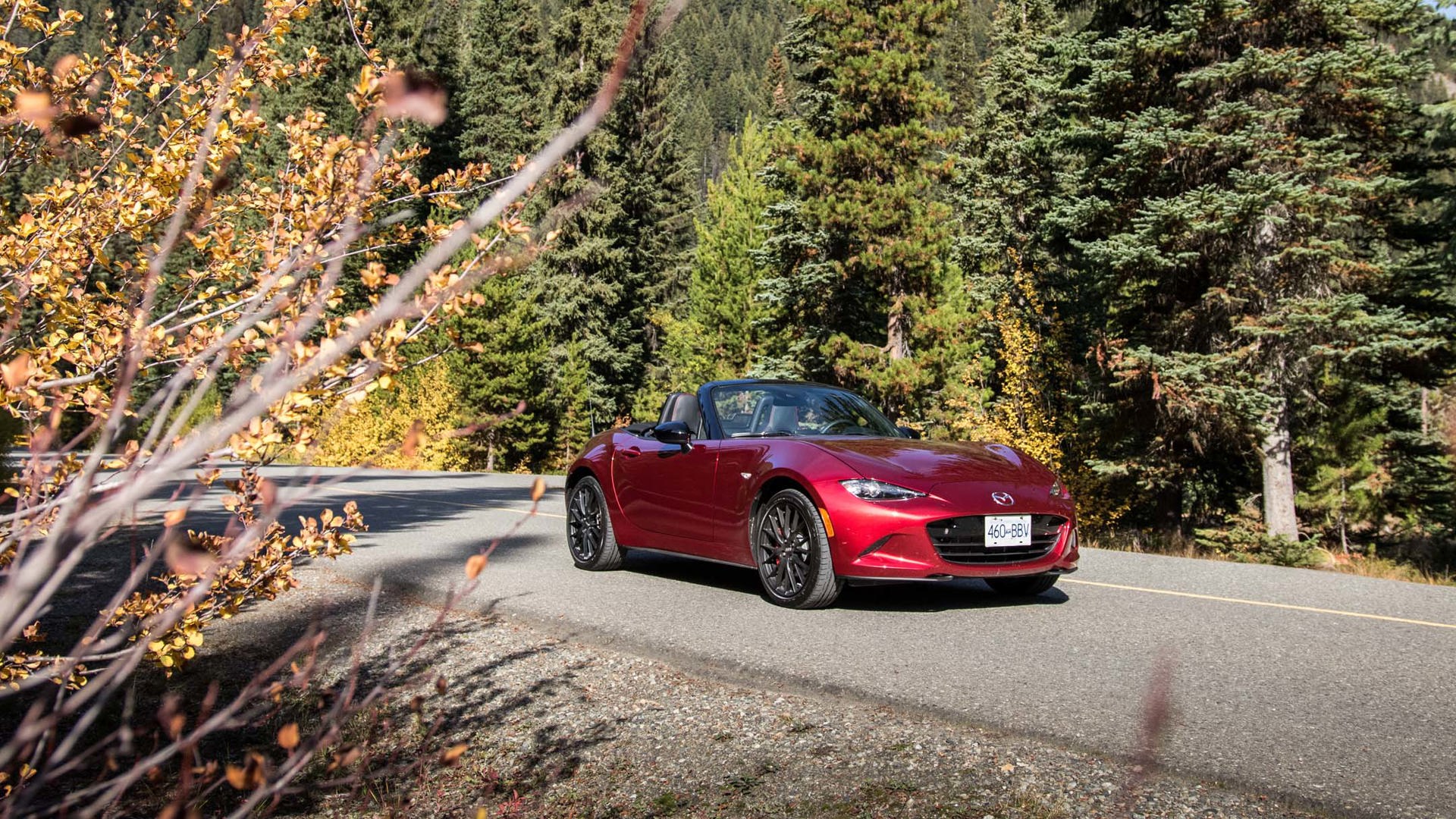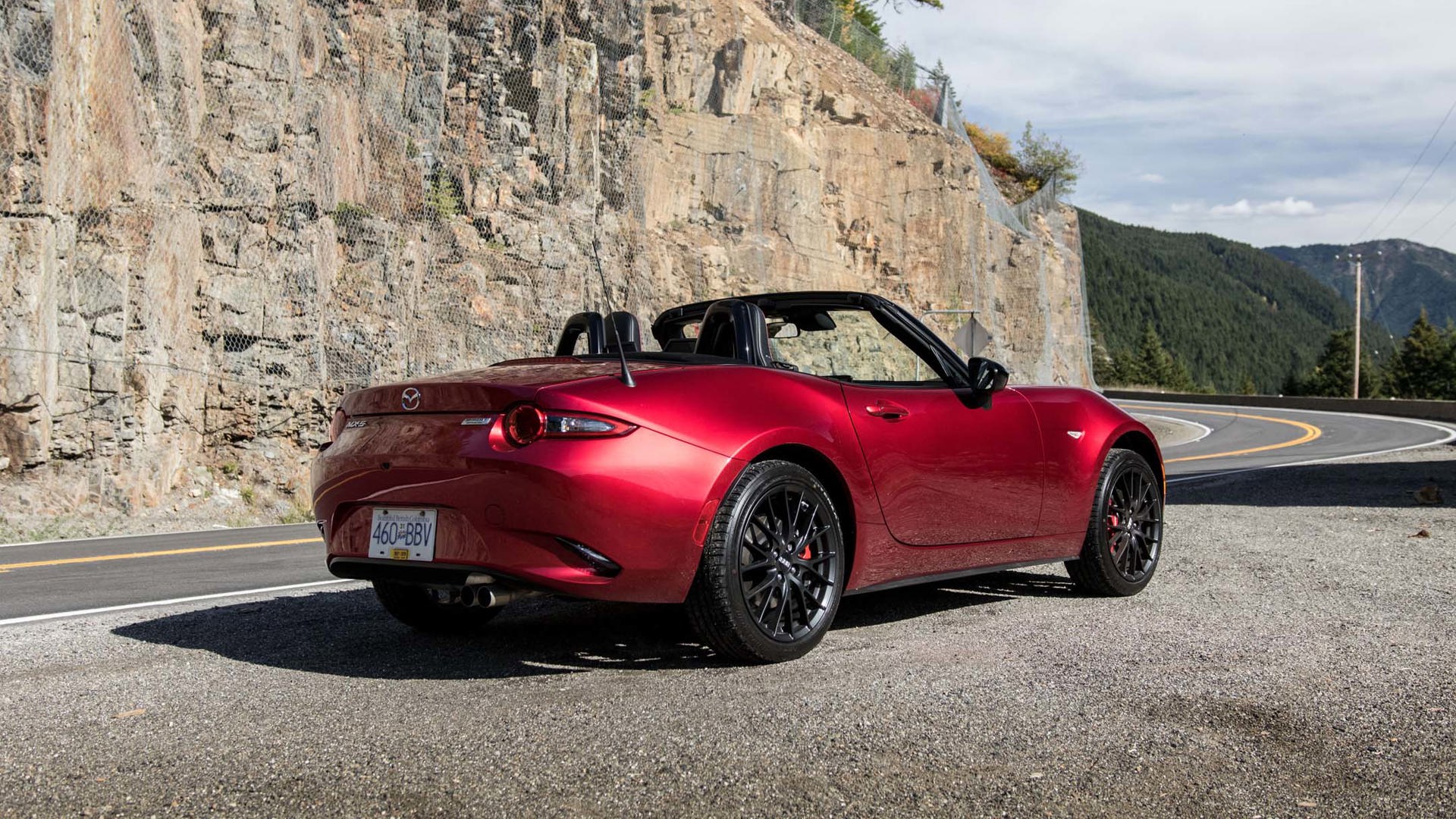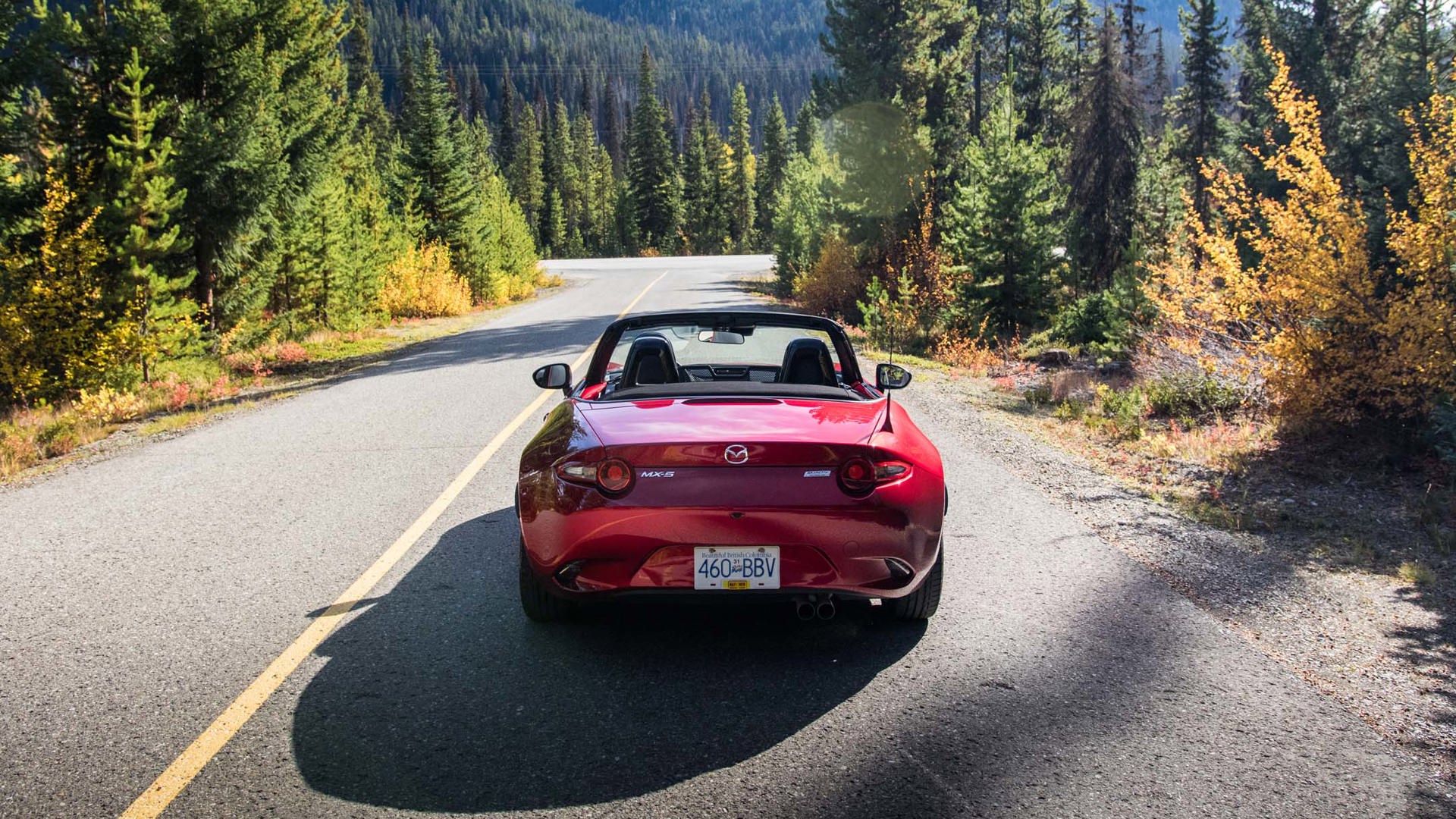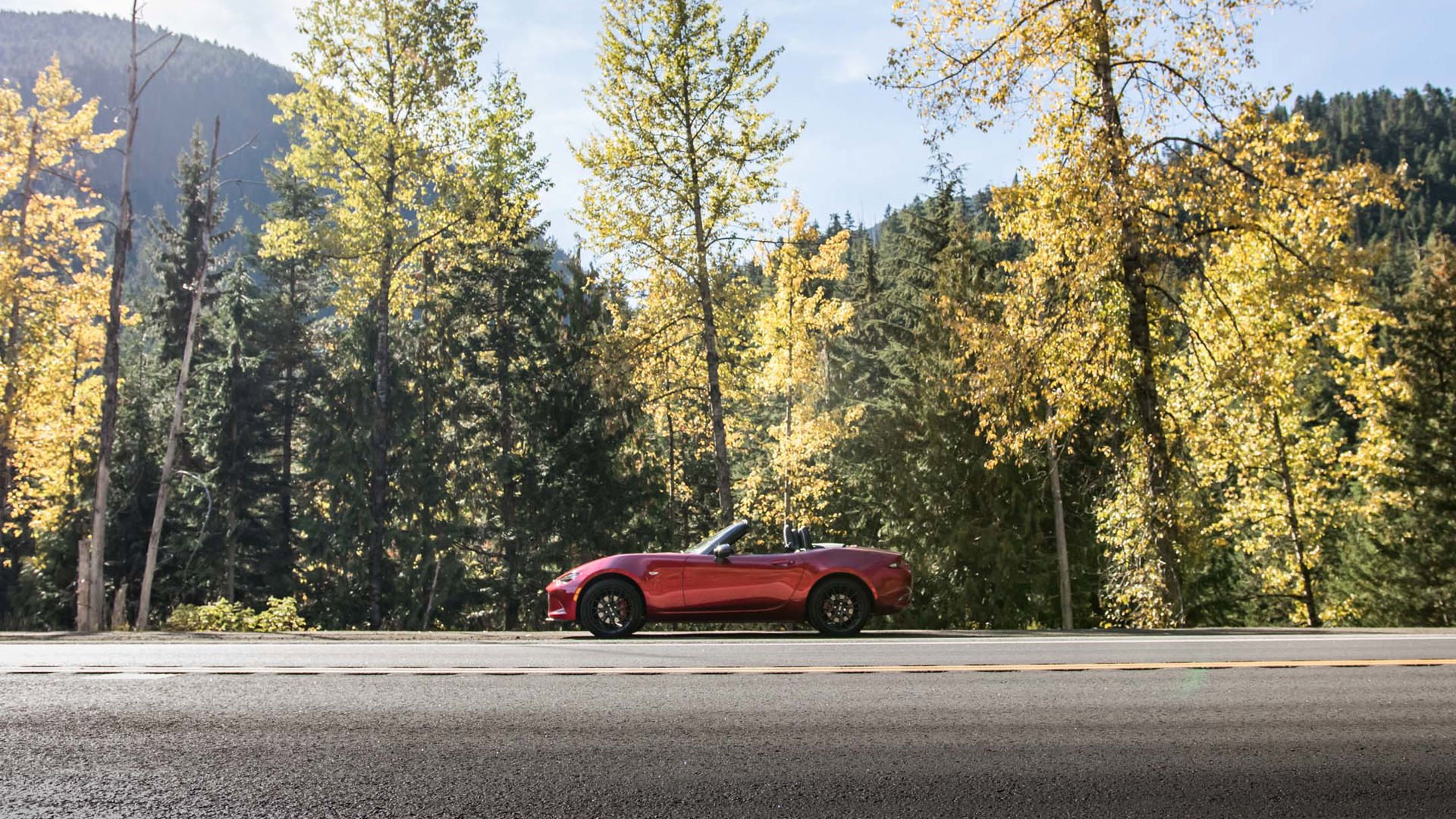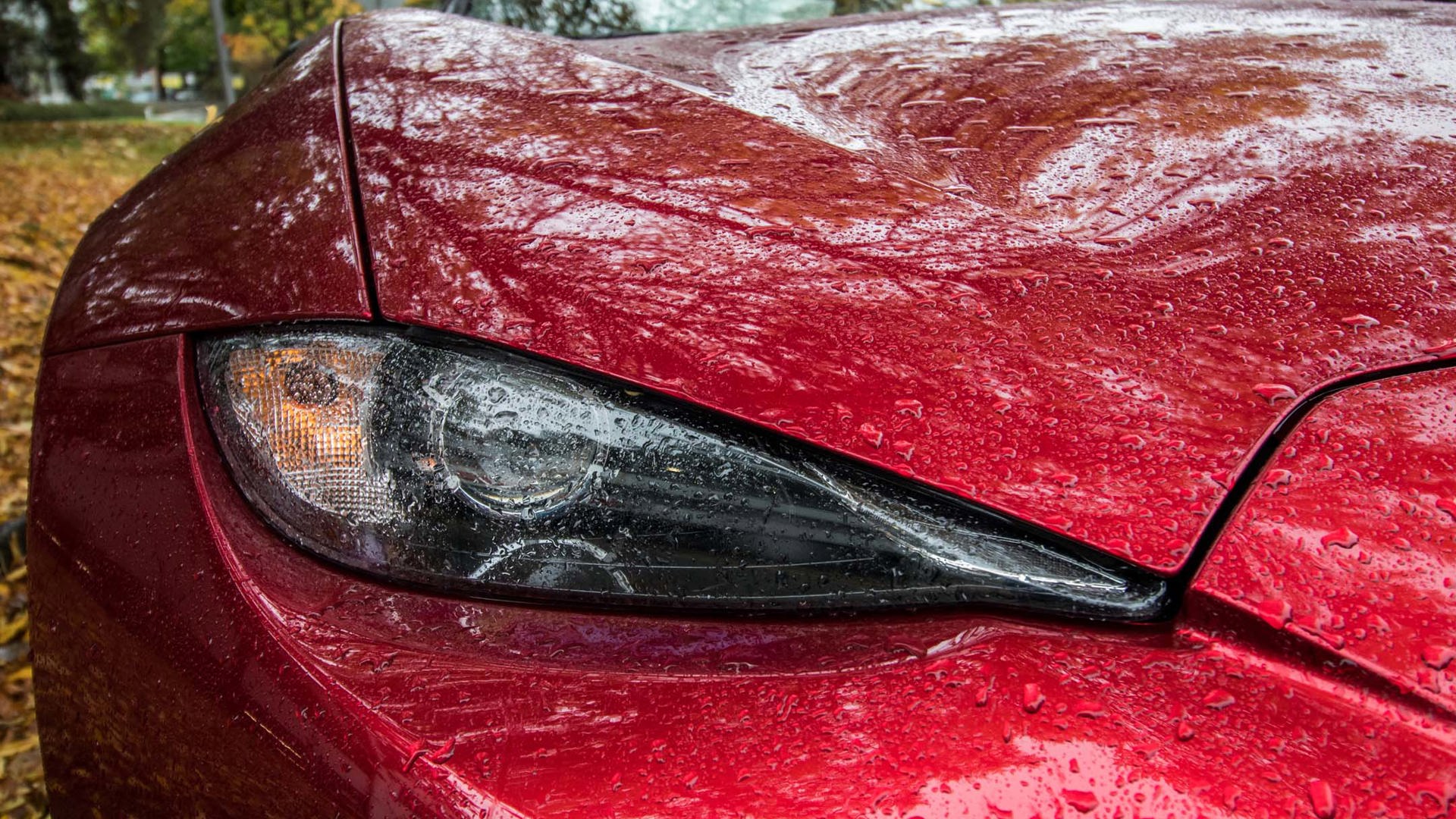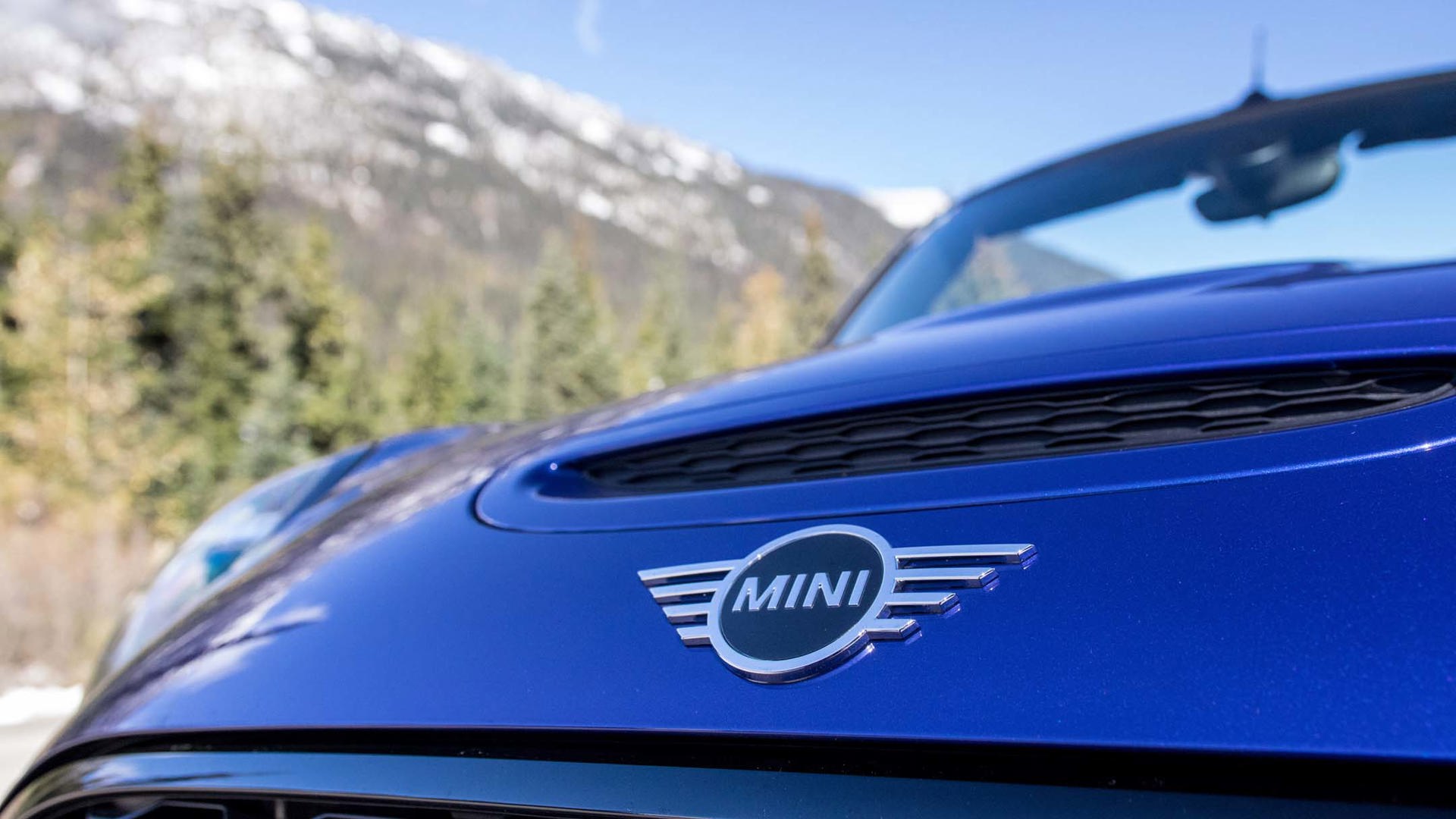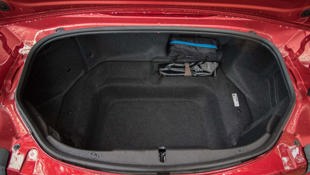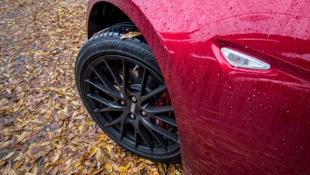Comparison Data
|
2019 Mazda MX-5 GS-P Sport
|
2019 Mini Cooper S Convertible
|
|---|---|
|
Engine Displacement
2.0L
|
2.0L
|
|
Engine Cylinders
I4
|
I4
|
|
Peak Horsepower
181 hp
|
189 hp
|
|
Peak Torque
151 lb-ft
|
205 lb-ft
|
|
Fuel Economy
9.0/7.0/8.0 L/100 km cty/hwy/cmb
|
10.3/9.3/9.8 L/100 km cty/hwy/cmb
|
|
Cargo Space
130 L
|
215 L
|
|
Base Price
$36,900
|
$33,990
|
|
A/C Tax
$100
|
$100
|
|
Destination Fee
$1,795
|
$2,475
|
|
Price as Tested
$43,645
|
$40,865
|
|
Optional Equipment
$4,850 – metallic paint $450; Sport package (Brembo brakes, 17-inch BBS wheels, sport seats, painted calipers) $4,400
|
$4,300 – Starlight Blue Edition (black exterior trim, 17-inch wheels, LED headlights and foglights, Harman Kardon stereo, leatherette, navigation, satellite radio) $2,900; Automatic transmission $1,400
|
The sun never set on the British automotive empire. Granted, former heavyweights like British Leyland did get their legs chopped off a bit in the 1970s. ’Tis but a scratch! While Rover and MG and Morris etc. are now, at best, shagged out after a long squawk, there is still a vibrant auto manufacturing industry in the UK these days. Why, they build the Civic Type R there.
Which car is the best of the British, without actually being British?
And as for all the brilliant automotive ideas championed by the Brits, those too have persevered despite a changing of the guard. Here are two: the Mini, now under the BMW umbrella; and the Mazda MX-5, faithful spiritual descendant of the classic British roadster.
While differing in seating layout, driven wheels, and design ethos, the Mini and the MX-5 are linked both by their dear ol’ Blighty roots, and by their intended use. When the air turns crisp, when the leaves are burnished gold and flicker as they fall, when the sky is robin’s-egg blue and the tarmac wriggles across the landscape like a young creek, it’s convertible time.
The question becomes: on a perfect autumn day, which of these machines is the one you want to have for dancing through the crunchy drifts of leaves? Which car is the best of the British, without actually being British?
Styling
With a face like an asp and a wasp-waisted body, the modern MX-5 is a far cry from the original Tic-Tac with pop-up headlights. It’s far more fierce-looking, and while there’s a recognizable “face” to the car, it’s a less friendly one. The front licence plate is also not particularly well integrated.
However, in this sparkling Soul Red, isn’t this a beauty? The MX-5 is not a cheap car by any means – please note the value section below – but it does look more expensive than it is. If you park one next to a Jaguar F-Type, the Mazda comes off strongly. It’s taken the classic proportions of roadster-dom, sharpened them with the accents of a modern era, and then added a flavour of Japanese calligraphy.
This particular version is the mid-range GS-P with sport package, so gets the 17-inch BBS wheels that set things off quite nicely. It does ride a little higher than some would like, but there are countless aftermarket options if you’d like your MX-5 to sit a little more snugly to the ground.
If the MX-5 is a pared-down Japanese interpretation of open-topped motoring, the current Mini range is a trifle cartoonish. The original Mini, before the CAPS-LOCK MINI renaming (which I refuse to adhere to) was typically clever solution to economical transportation, dreamed up by the people who made it through WWII rationing with pluck and inventiveness. The BMW-designed version is self-consciously cute.
Or perhaps cute is the wrong word here. The first generation of reborn Mini has aged well and is still plenty of fun to drive. This new version has a bit of a stunned fish look about it. The LED rings around the headlights are a clever way to create a link to the past, but the car is only small by modern standards. 17-inch wheels look huge on the MX-5, but a perfect fit for the Mini.
The self-conscious, tongue-in-cheek cutesiness is real, and everywhere. Of particular note are the Union Jack taillights, which are about as subtle as an elbow in the ribs. Nudge-nudge wink-wink brake-brake grin-grin know what I mean, guv? Still, even though they’re a bit twee, apparently the UK-centric details are popular options even in Ireland, which doesn’t usually much go in for the ol’ Union Jack, for obvious reasons.
In short, the MX-5 is serious, and the Mini is jokey, bordering on forced humour.
Interior, Comfort, and Utility
As much fun as these two machines look, they still have practical functions to live up to. Perhaps less so with the MX-5, as it’s a potentially summer-only car, purchased as a reward for years of work when the kids are finally out of the house.
However, countless Miatas have functioned as daily drivers over the years, beloved for their ability to provide almost all the classic British motoring experience except for the bits where you have to get out and push. Viewed through an everyday lens, the MX-5’s sharp focus on a driver-centric mission comes apart at the seams a little bit.
This is a very small car, with a smallish (130 L) trunk. The cupholders are afterthought-hilarious, interior storage is minimal, and even though there’s now a tilt and telescoping wheel for greater flexibility, taller drivers will still have a bit of trouble fitting in.
Sidebar: If you’ve been considering a used MX-5, there’s no better time than to check out the previous generation car, dubbed the NC in most Miata circles. Widely considered to be the “worst” Miata – it’s the largest and heaviest – it is nonetheless a fantastic little car that’s unaffected by either the nostalgia for the older cars, or the renewed interest in the now more-powerful new machine. They’re about as cheap as they’re going to get for low-mile examples, and the power hardtop makes it an even better all-weather option.
In terms of cockpit design, however, the MX-5 is close to ideal. Some controls are awkwardly positioned by the driver’s elbow, but the overall feel is that you wear this car like a second skin, with everything within easy reach. The sport package comes with really grippy Recaro seats, but the standard seats are just fine at blending lateral grip and comfort. The roof mechanism is absolute genius in its simplicity.
Where the MX-5 pares back, the Mini lays on the options with a trowel. On the plus side, this is a much more upscale interior than the previous Mini offerings, which tended towards plastics that ended up creaking and rattling like Prince Phillip’s knees. This is a pricey little car, but the interior now feels finally up to it.
The large central display, which used to be a speedometer but has long been abandoned to infotainment duties, has a coloured mood ring that changes depending on your driving style. The starter switch is a brightly coloured triangle in a retro-style toggle switch array.
This latter is a bit of a bummer as my tester was missing some option or other, so instead of a button blank I got a missing toggle. Even so, the rest of the Mini’s interior was up to junior-BMW standards, with supportive seats that included adjustable lower thigh support for drivers with longer legs.
Additionally, something the Mini can do that the MX-5 can’t is carry a couple of extra passengers. If the Mazda is perfect for empty-nesters, the Mini still has room (just) for a couple of kids to ride along. From personal experience, they will insist on top-down motoring all the time, even though there’s not much in the way of heat back there.
The two-stage roof that has first a sunroof option, then a full opening that can be performed at speeds up to around 30 km/h. It takes 18 seconds to fully drop the top, and you have to hold a button mounted high up on the windscreen the entire time – it’s a bit of a blend of convenient and inconvenient, but better than the MX-5’s hardtop variant, the RF.
Rear legroom is, as you’d expect, pretty tight back there even for small kids, and the 225 L trunk has a small opening. Still, it’s better than the MX-5’s and there’s the option to flop down the rear seats to haul something large home from the big box store.
Overall, the MX-5 requires compromise to enjoy its rewards, while the Mini is surprisingly flexible. Here at least, both actually faithfully mirror the cars that inspired them.
Technology
We’ve come a long way from the original technology associated with these cars’ British ancestors, which mostly featured innovations like the Lucas Electrics self-shorting circuit. On a reliability note, I’d trust the Mazda long-term a great deal more than I would the Mini; on a functionality scale, both are very well equipped.
Mazda’s infotainment isn’t particularly flashy, but it functions well. Twin USB connections and a recessed pocket in the dash allow for easy smartphone storage, and the rotary dial control gets more intuitive the more you use it. Apple CarPlay and Android Auto are rolling out across the Mazda range, and while my tester did not have them installed, it’ll be available as a retroactive add-on.
Also of interest is Mazda’s integration of safety features across the MX-5 range. Expected stuff like blind spot monitoring, cross-traffic alerts, and lane-departure warning are all present, but so too is a low-speed automatic braking system. This latter uses a laser mounted high in the windshield, so should work on the crossovers that infest our modern roads, even though the MX-5 is quite low.
If the Mazda has useful functionality, the Mini is a technology showcase. As the brand is under BMW’s direction, Mini can borrow from the Bavarians when it comes to touchscreens and control options. Thus, the Cooper S comes with BMW’s rotary knob and touchpad controller, as well as a touchscreen featuring excellent graphics and a relatively intuitive interface. One particularly handy function is the ease of hooking up your phone to Apple CarPlay services, but then flipping to use the onboard navigation, thus saving on data usage.
The Mini also has features plenty of optional extras, including dual-zone climate control, and an app for extra connectivity. In theory, this latter is a genius idea, letting you sync your appointment addresses right into the navigation display. In practice, the app is poorly reviewed on the iTunes store, as it seems to suffer from buggy updates and occasional connection woes.
Again, as is becoming a common theme, the Mazda offers a cleaner approach and the Mini a deeper and more complex one. When everything’s working on the latter, it’s the superior option, but that complexity can all too easily turn to frustration.
Ride, Performance, and Handling
On to the real reason why someone might consider purchasing one of these cars: the drive. The current generation of MX-5 has received reams of critical acclaim for its driver-centred approach, lightweight charm, and return to the feel of the original. This 2019 model sees a not insignificant power bump, one the car didn’t really need, but one that’s welcome nonetheless.
The Cooper S, on the other hand, seems to have steadily drifted further away from its roots with every iteration since the R53-chassis supercharged variants. If you look at the Mini range as a whole, vehicles like the Countryman and five-door Mini don’t really seem to fit the ethos of the brand. Everything just feels a little too embiggened – who wants a bigger Mini?
However, a pair of perfect days provided ample opportunity to measure the MX-5 against the hype, and the Mini against the fun of the past. First, I set the MX-5 a long-distance drive into BC’s interior, sweeping up through the coastal mountain passes.
If you’ve driven a Miata, everything you loved about the experience is here, with a bit of extra zip to go with it. The chassis is still a sparkling delight, with enough body roll to let even a less experienced driver understand what’s happening with weight transfer. The MX-5 isn’t exactly roly-poly, but it does lean a little when you take it into a corner quickly, taking a set, and allowing the driver to pitch weight fore or aft depending on throttle or braking application. The ride’s also surprisingly good for such a little car.
The electric-assist steering isn’t quite as lively as the totally power-free helm of the original (but what is?), but everything else about the MX-5’s behaviour is delightfully transparent. The longer you’re behind the wheel, the better a driver you’ll become, simply because this car rewards skill with momentum.
However, real life is not a series of perfect, sweeping downhill curves blissfully free from obstacles. Time and again in the MX-5, a rhythm of corners and rev-matched downshifts would be interrupted by the sight of a hill and a slow-moving semi-trailer trudging up it. Passing sections were shortish and few, and in an early Miata, you’d have your work cut out for you.
This new one features a reworked 2.0L engine, which has benefitted from lessons Mazda learned on their overseas-only 1.5L four-cylinder. Thanks to larger valves, linked intake ports, and a lighter rotating assembly, Mazda’s four-cylinder now produces 181 hp, and has a broader powerband. It’s not a Honda S2000, but it still rewards when you spin the tachometer up into the rev range. It’s genuinely quick in a straight line, not just in the corners, which means that you can blast past the big rigs, and out into the sunshine again.
After two consecutive four-hour drives in the MX-5, I couldn’t wait to hop back in it again. Conversely, the Mini Cooper S left me feeling cold. Mind you, that might have been the snow on the verge of the road.
Initially, the Mini was a charmer. The grouper-on-ice face doesn’t do much for its charisma, but with the top down and car seats loaded in the rear, my daughters fell all over themselves in a race to load up. If you’re a father, the silvery peals of laughter coming from behind you are a far better accompaniment to any fun drive than the loudest aftermarket exhaust in the world.
And, around town, the Mini was zippy and a little bit flatulent out its twin-piped exhaust, and generally good fun. Chuckable is the word most commonly associated with the breed, and if this car is bigger than its ancestors, it doesn’t much feel it. Torque is instant from the turbocharged 2.0L engine, and it’s feels far more responsive and peppy than the MX-5 for nipping about between the stoplights. Opting for the six-speed automatic transmission doesn’t feel like a mistake either, given the Mini’s urban appeal.
Roll in the powerful stereo blasting some favourite kid tunes (we’re on an Imagine Dragons kick, heaven help us), and the Mini is a city-slicker’s delight. As an additional bonus, the stereo drowns out the tendency for the Mini’s interior to creak over bumps, and occasionally rattle. The run-flat tires are also very bumpy.
The MX-5 feels best exercised top-open on open roads, but the Mini was perfectly happy in stop-and-go traffic. Further, its upright windshield gives the car a much airier, more open feel than the MX-5’s cockpit-like environment. It’s good, lighthearted fun.
Amped up from all this terrier-like sniffing around in traffic, I headed up the Sea-to-Sky, and beyond into the mountains. On such a crystalline day, the purity of the air and the emptiness of the road would surely be an ideal pairing for an open-topped Mini.
It sort of was. The Mini was very good up the switchbacks, and if the steering wasn’t communicative much, the short wheelbase and relatively stiff chassis let you know what was happening. It was quick as anything, particularly in the most aggressive of the driving modes, but there was something lacking in driver engagement. Perhaps a manual gearbox really is a necessity for that last bit of fun – you don’t get paddle shifters as standard.
Up and down the Mini ran through some of my favourite roads in the province, and mostly I just got cold and had to crank up the heated seats. It would have been a better shared experience, perhaps in warmer weather, but where the MX-5 had me thinking about looking for other windy roads, the Mini wasn’t really any more fun in the twisties than it was in the city.
Value and Economy
Per pound, neither one of these cars is particularly good return on your money. They are slight of horsepower, and small of stature, yet not shy on the price tag. Both are around the $40K mark before taxes, which would get you (not a direct comparison) a reasonably equipped Mustang convertible or similar.
However, it’s probably the MX-5 that’s the smarter choice here if you’re just looking for resale. Because it’s such a recognized and trusted nameplate, even quite elderly Miatas are still worth a surprisingly large amount. This new one, with the uprated horsepower, will be more sought after than the 2018 model, and relies more on the appeal of its engineering rather than its technology.
The Mini, conversely, is an ideal car to lease. Own and enjoy it during the warranty coverage period, and then maybe try something else out for a change. Perhaps there’ll be an electric version in the near future that’ll be even better as an urban runabout. Of the two, this is the one you enjoy in the moment, and then move on. The MX-5’s the one that feels made for longer-term ownership.
In terms of economy to run, both vehicles require premium fuel, but the MX-5 is a little more parsimonious in the way it sips it. Both have hilariously small fuel tanks, at 44 L for the Mini, and 45 L for the MX-5.
Conclusion
Perhaps it’s not so surprising that these two should have such city-mouse/county-mouse opposing personalities. After all, Britain is home to both the bustling sprawl of London, and the lonely splendour of the B-road. The best fit is really going to depend on the type of driving you do.
However, there is a clear winner. The common thread linking something like an MGB and an original Mini is their simplicity and purity. Both are relatively needy cars, forever needing repairs and spares, but they reward with a mostly unfussy driving experience.
The MX-5 is a faithful copy of this idea, albeit one built to a slightly higher standard. This is the car you save up for, that you keep going for years, that you experience the lasting pride of ownership. Despite the march of technology, the Mazda holds true to the driving ideals of the past.
The Cooper S, on the other hand, feels more like a synthesized version of what the Mini ideal could be. It’s plenty of fun, and a bit more practical, but there’s a lot of design and engineering going on here. It’s a complicated replication, rather than a pure tribute to an ideal.
Even with the practicality considerations, I’d rather have the MX-5 and a good, paper map. Chart a course. Topped up on petrol. Top down for driving. Tally-ho, chaps, and no stopping until tea-time.



